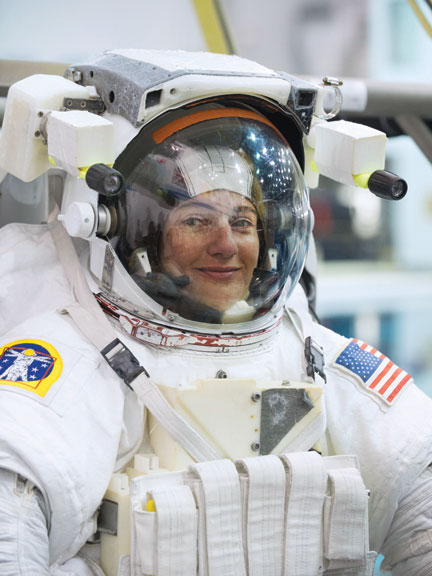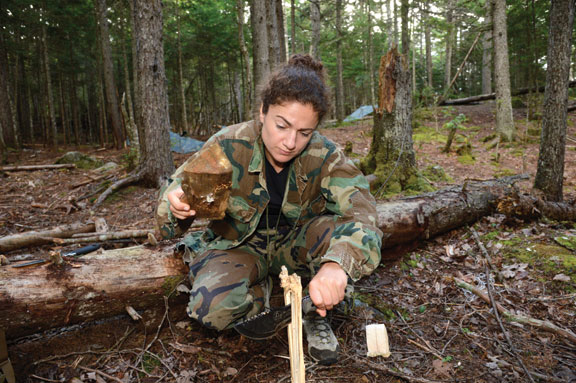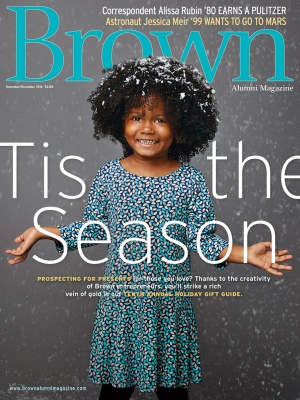Astronaut Jessica Meir ’99 is torn. As an amateur but devoted musician, she’s concerned that bringing a saxophone into space might be too unwieldy. She could bring her flute, but there’s already been a flautist up there, and besides, she explains, the denizens on the International Space Station (ISS) usually have a guitar on hand. So, after intense deliberation, she decides that taking her piccolo makes the most sense. Leave it to a Brunonian to take such nuance into consideration when peering into the cosmic vault.

Of course, Jessica Meir has more pressing concerns than who will play what in space. Despite a master’s in space studies from France’s International Space University, a doctorate in marine biology from UC San Diego’s Scripps Institution of Oceanography, and a teaching position at Harvard Medical School—not to mention her ability to pilot jets and scuba dive—Meir, a Brown biology concentrator, has a lot to learn. I met her in Houston one morning as she underwent one of her countless trainings to prepare for life aboard the space station.
It’s 8:00 a.m. at the Neutral Buoyancy Lab (NBL) in Houston, and Meir has arrived wearing spandex long johns covered in what looks like large macaroni pasta, but which in fact is part of a liquid-cooling and ventilation system worn under her astronaut’s suit. The NBL is where astronauts train for spacewalks from the ISS. It features a forty-foot-deep pool that holds more than six million gallons of water—nine times more than an Olympic-size swimming pool. Even so, the pool isn’t big enough to hold a scale replica of the entire space station, so the station is broken down into separate modules, as if it had crash-landed into the water. (In reality, the modules are lowered into the pool using cranes.) A battery of technicians is hard at work negotiating Meir into her spacesuit. “Slow is fast” is the NBL mantra, and the whole process of gearing her up is deliberate and time-consuming.
After fifteen minutes, Meir has wriggled and twisted her way into what may be the most unwieldy pair of pants on this or any other planet. In them, Meir trundles over to a large platform and, assisted by another team of technicians, she’s helped into the top half of her suit. Next, a tool set is attached to the front of her spacesuit, and she dons what looks like an old smash-mouth football helmet, or, as it’s known here, a “Snoopy Cap.” Finally, as she is lowered slowly into the pool, she gives a wave and, supported by the water, begins working on the submerged model in a state as close to weightless as you can achieve on Earth.
With Meir are four scuba divers. Two monitor her safety while the third films her with an underwater camera and the fourth provides Meir with training tools as she simulates a spacewalk, or extravehicular activity (EVA). During a six-hour session, Meir practices routing cables, testing and repairing equipment, and other tasks she’ll have to perform while living on the ISS.
Just looking over the edge of the pool at the colossal environment forty feet underwater is disorienting. A sense of vertigo sets in as I watch Meir and the divers work. But extreme environments are familiar to her. She has worked in the Antarctic studying the physiology of diving emperor penguins. She has spent days on end living and working sixty feet underwater at the Aquarius research station for NASA’s Extreme Environment Mission Operations (NEEMO) project. Last summer, she and a team of astronauts spent six days living in a system of caves in Sardinia. And, right after graduating from Brown, she took her first of many flights on NASA’s reduced gravity aircraft, the aptly named “Vomit Comet”—for which she made the cover of the September/October 1999 BAM. Meir clearly feels at home at the limits of human functioning.
“I’ve always been interested in extreme environments,” she says. “I think the times in my life when I’ve been most content have been when I have that combination of mental and physical challenges, whether it’s designing experiments and testing them in an underwater environment or shoveling snow for hours and hours in the Antarctic.” It’s an attitude that has helped land a legitimate shot to be one of the first people on Mars, 140 million miles away, where the average surface temperature is around minus-81 degrees Fahrenheit and a ceaseless bombardment of harmful radiation makes visiting a problematic proposition.
In 2013, Meir was selected from a pool of more than 6,100 candidates to join the eight men and women of Astronaut Group 21 (the first group with a one-to-one male-to-female ratio). Aboard the ISS, Meir, along with these seven other astronauts, will blaze the trail to a mission to the Red Planet. By testing technologies and systems critical for deep space missions, by gathering physiological data to determine how our bodies react to microgravity and particle radiation, and by running scientific experiments with applications both for space and for down here on Earth, Meir and her colleagues will help us take the small early steps needed for our greatest leap yet.
With such a robust résumé, it’s hard to gauge whether or not there’s anything Jessica Meir can’t do, so to figure out her true specialty, I have to resort to asking her.

When pressed on how often she actually thinks about participating in a manned mission to Mars, Meir is circumspect: “To be honest, I don’t think about Mars all that often, because here’s the thing: Right now, our crucial manned mission is aboard the International Space Station. That’s probably the first mission that everyone in my class will have, but of course we’re always looking further. Our tagline is, ‘This journey to Mars,’ and it really is a journey. Right now we don’t have a congressionally funded mission to Mars, but it’s definitely the end goal of everything we’re doing now.”
It’s very weird to hear someone talk so casually about life in space. Meir relates her responsibilities and concerns with disarming coolness, so as I talk to her I try to seem cool too, but the truth is I can’t even fix the toilet in the guest room. Many of us have dreamed of going into space, but very few of us follow through with the years of necessary education and preparation. None of this seemed so arduous when we were watching Space Cowboys.
For Meir, however, space flight was never really a “what if?” She says she was committed to becoming an astronaut since she was a young girl growing up in Caribou, a town in far northern Maine with a population of just over 8,000 people. “My mom,” Meir says, “tells the story that I said I wanted to be an astronaut when I was five years old. Then in first grade—and I remember this—when they asked us to draw what we wanted to be when we grew up, I drew a picture of myself standing on the moon. I’ve always been fascinated by exploration and the unknown, and becoming an astronaut, I think, is just the natural extension of that early allure.”
Meir’s freshman roommate, Jaclyn Mason ’99, a fellow biology concentrator and now a lawyer, remembers seeing this passion and drive up close. “Jessica was always intent on being an astronaut,” she says. “The funny thing is, even though we met when I was seventeen, I never doubted she would realize her goal. I think if anyone else said that they wanted to be an astronaut, most people would dismiss it as a pipe dream, but no one did that with Jessica.”
Mason also notes that much of what Meir has achieved can be traced back to her time at Brown. “It was such an amazing academic institution, especially for women in science,” she says. “In our core group of ten female friends, seven of us graduated with degrees in science, and many of our classes were dominated by women. Plus, with Jessica, apart from her extraordinary intelligence, drive, and commitment to her work, she has an ability to make friends and relate to people in all walks of life, no matter where she goes.”
In addition to her space ambitions, Meir also came to Brown with a passion for biology that had been instilled by her teachers in Caribou. And while most members of the astronaut corps have specialties in physics and engineering, Meir says, “I was pretty sure I wanted to major in biology.” She remembers fondly one of the first times she saw how biology and outer space could be combined. It was at NASA’s Space Life Sciences Training Program at the Kennedy Space Center (KSC), which she attended between her sophomore and junior years.
“I went to KSC for six weeks,” she says, “and everything was focused on space life sciences. I was growing tomato sprouts under an altered gravity environment, and we had hands-on instruction and lectures from various scientists and astronauts, and I thought, ‘Aha! There is an outlet for life sciences here.’”
While studying biology at Brown, Meir was also a member of the Diving Club, the Flying Club, and the Wind Symphony, all of which have contributed to her versatility in the astronaut program. She also credits a number of faculty members who helped focus and inspire her pursuit of becoming an astronaut, many of whom remain friends and colleagues today. One in particular stood out.
“Professor Ken Miller in biology made a really strong impression on me,” she says. “He taught my introductory biology class, which he didn’t have to teach. But I think he felt it was so important to really foster interest in the field, so he approached the class with incredible enthusiasm. Right after I got my PhD, I saw him at a conference where we were both speaking, and I went up to him afterward and said ‘Hey, I wanted you to know that I just got my PhD, and I wanted to tell you that you were one of the main reasons I stayed in biology.’ He gave me a big hug and said, ‘That’s why I do what I do.’”
Of course, as a Brown student Meir didn’t restrict herself solely to science. “Actually,” she says, “some of my favorite memories of classes at Brown were my Swedish classes with Ann Weinstein.” (Meir’s mother is a native Swede.) “After the introductory courses, Professor Weinstein held class in her living room. It was wonderful. She used to joke that I had to bring a Swedish flag to space, which I plan to do.” (When Sweden found out about Meir, she became known there as the first Swedish-American astronaut. “Hey, I’ll take it!” says Meir, with a smile.)
The night before her graduation, Meir found herself on the dance floor with one of the most recognizable figures in the history of spaceflight. Jaclyn Mason recalls watching her roommate dance with John Glenn at the senior dinner. “[Glenn] was being honored during our commencement festivities,” Mason says. “Who knew then that one of our country’s first astronauts was dancing with a future astronaut, who could potentially make one of the first trips to Mars?”
At graduation the next day, Mason recalls, Jessica’s father held up a sign that read, “Congratulations, Space Girl!” “It was so cool,” Mason says. “All our friends and family still talk about it.”
While she was studying at the International Space University near Strasbourg, France, Meir received a call from the Johnson Space Center (JSC) in Houston offering her a position in the Human Physiology Program. Meir worked in Houston at JSC for the next three years—2000 through 2003—as a support scientist, helping to research how the conditions in outer space affect the human body.
“Working at JSC on experiments designed by other scientists really made me want to run my own,” Meir says. She left to attend the Scripps Institution of Oceanography, where in 2009 she earned a PhD in marine biology (with a focus in diving physiology). That year she completed her first application to NASA to become an astronaut. “I said I’d never come back to Houston unless it was to become an astronaut,” she recalls.
Meir made it to the final round of candidate interviews but wasn’t ultimately selected. “I was heartbroken,” she says. But NASA officials encouraged her to reapply. One of her first realizations in 2013 upon hearing she was selected for the twenty-first class of astronauts was, “Wow. I’m going to get to do [for free] a lot of things I had to spend so much of my savings to do in the past.”
What followed was an intense two-year training period in which Meir and her fellow astronauts were taught survival skills and given flight training in high performance T-38 jets. Spacewalk simulations, space station systems training, intense Russian language lessons, and robotic-arm instruction are just a few of the things covered in the astronaut training period. Meir is quick to point out that, while it’s true she and her astronaut colleagues will constitute the collective face of the space program, they are really just “operators” doing the visible work of what is primarily being done on the ground.
“Is this where you try to tell me astronauts are normal people?” I ask.
“I promise!” is the response from Dr. polyglot-musician-professor-at-Harvard-Medical-School and astronaut Meir.
“I know people have a weird perception of astronauts,” she says. “We’re this iconic image of human space flight, but all the experts are down here on the ground. The people that build the rockets, everybody that trains us and teaches us what we need to know—that support everything we do—those are the experts.
They may be the experts, but they won’t get the view. “I’ve always imagined looking down on the planet,” Meir says. “When it’s only you, removed from everything else—just to see that blue ball that contains everything you’ve ever known and everything you’ve ever done. I think of the importance of that, and not on a selfish level. The first Earthrise picture [taken in 1968 by astronaut Bill Anders] was a big propellant of the environmental movement. The human species needs that perspective.”
At Mission Control here in Houston, Meir is currently the lead Capcom (Capsule Communicator), who is the primary liaison between the ground and the astronauts aboard the ISS. Every day she’s faced with a unique set of administrative and leadership challenges, from interpreting critical mission data to translating the information that’s traveling to and from the ISS. And, she says, “Since we have people up there 365 days a year, it’s really cool because I’m doing something different all the time.”
Right now, Meir and the members of her astronaut class have no set date for their maiden voyage up to the ISS, but she keeps busy. Along with her duties in Mission Control, her NASA outreach appearances, and her continued space training at the Neutral Buoyancy Lab and the Johnson Space Center, Meir is trying to make a little noise off the launch pad before her first trip.
“At Brown I played in the wind symphony,” she explains. “I played flute and piccolo, and I also played in the pit band for various musicals. And there is actually a band made up mostly of astronauts. They’re called Max Q. I don’t think a lot of people know this, but my other childhood dream goal was to be in a symphony that played for movie soundtracks—the really dramatic score music—John Williams kind of stuff.”
“So you’re also in an astronaut band?” I ask her, thinking my next question should reference her ability to part the Red Sea.
“Well,” Meir admits, “there was a meeting I was supposed to go to a little while ago, but I missed it. I’m not sure I’m going to be playing with them any time soon.”
Sometimes the laws of space and time won’t cooperate, but don’t tell that to Jessica Meir. She’s got a flight to catch.
Tyler Smith has written for the Utne Reader, Esquire, McSweeney’s, Texas Monthly, and other publications.





